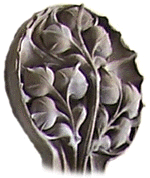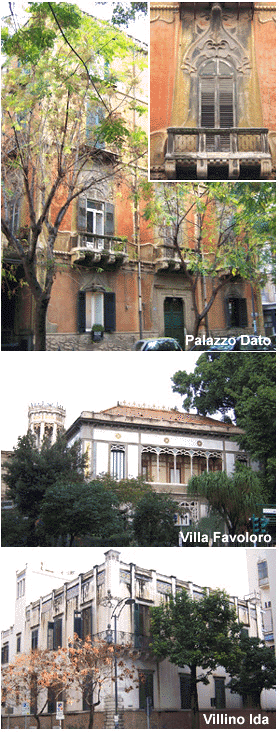...Best of Sicily presents... Best of Sicily Magazine. ... Dedicated to Sicilian art, culture, history, people, places and all things Sicilian. |
by Carlo Trabia | ||
Magazine Index Best of Sicily Arts & Culture Fashion Food & Wine History & Society About Us Travel Faqs Contact Map of Sicily |
Like Art Deco, Art Nouveau was a total style encompassing architecture, interior design, painting, graphics, fashion, furniture design and other areas. Unlike Art Deco, it looked directly to nature for its inspiration. In design the glass of Louis Comfort Tiffany (an American) comes to mind, and much of the art of Gustav Klimt, Henri de Toulouse-Lautrec and Maxfield Parrish may be classified as Art Nouveau, which in Germany was "Jugendstil" and in Spain "Modernista." In Sicily the greatest centre of the Art Nouveau was Palermo, where hundreds
of examples can still be seen. So many buildings were constructed in the
style on a single new street that Via Libertà ("Liberty Street") was named after the movement. While most visitors come to Palermo to see Giovanni Battista Basile was the first local architect to experiment with the new style. Villa Favoloro (in Piazza Virgilio off Via Dante) was built to his designs in 1889. Certain elements of Villa Igiea and other structures adhered to the new forms, and before long entire city districts were designed in Italianate Art Nouveau. Architect Ernesto Basile followed in his father's footsteps, to be joined by Vincenzo Alagna and others. Two particular areas are dominated by the Art Nouveau: Via Libertà and the streets running off it between Politeama and the Giardino Inglese, and Mondello (a seaside district outside town). Palazzo Dato (at Via XX Settembre 36), designed by Vincenzo Alagna, seems to epitomise the Art Nouveau. Around the corner (at Via XII Gennaio 32), Villa Failla is another fine example of Sicilian Liberty. Ernesto Basile's own home, Villino Ida (at Via Siracusa 15), completed in 1904, is Art Nouveau with a touch of what looks a little like early, geometric Art Deco. Villino Caruso, designed by Filippo La Porta during the same period, is a fine example of the new movement, inside and out. The interior of the Teatro Massimo (the exterior is Neoclassical) features some Art Nouveau paintings and decoration. Villa Malfitano, the Whitaker home in Via Dante, has a few very early Liberty elements, though that is not its principal style. In contrast to many architectural styles, the Italian form of Art Nouveau is obviously eclectic and varied. Certain elements more often associated with the Neoclassical or even the Rococo find expression in the context of Italianate Art Nouveau, making it difficult to define the external architecture of certain buildings as "Liberty." More often, it is their interior decoration that justifies the definition --things like wall murals and painted ceilings reflecting, to some extent, the indirect Japanese influences on early Art Nouveau. There's also a dash of Gothic in some Liberty style buildings. About a decade would pass following the rise of Fascism (1922) before the new "Socialist Classicism" (typified by Palermo's courthouse and main post office, and EUR outside Rome) and Bauhaus architectural styles completely supplanted the Art Nouveau in Italy. The most impressive Liberty buildings --mostly residences-- will be seen in Palermo, Milan, Turin and Rome. In most cases, it was the "new rich," rather than the nobility or bourgeoisie, who commissioned such structures. That construction of these luxurious homes reflected a general prosperity would be an overzealously optimistic statement. While the prosperous classes were growing, and challenging the old aristocracy for power (Palermo's Florios come to mind), they represented little more than a tiny fraction of thepopulation, and even today Sicily cannot be said to have a very large or sophisticated middle class. The Art Nouveau was the last desperate breath of a new class seeking to express itself. By the 1970s Palermo found herself saturated with unattractive architecture designed, more often than not, according to the opportunistic and parsimonious whims of the poorly-educated owners of Mafia-controlled construction firms quickly established to cash in on political support, and then just as quickly dissolved to hide criminal tracks. Not only did the so-called "Rape of Palermo" result in new neighbourhoods, it led to the destruction of many historic homes along Via Libertà, leaving ugly mini-skyscrapers in their place. Thus, no matter how much of the Liberty style one sees in Palermo today, there used to be much more of it. There's a little Liberty everywhere in Palermo. Movie houses, theatres, stately homes, a kiosk across from the Politeama opera house, and a number of monumental mausoleums in the local cemeteries were built in this distinctive style free from conventional architectural strictures. Nevertheless, the significance of the Italianate Art Nouveau in Sicily is often overlooked, perhaps because the term "Liberty" is so elusive to those unfamiliar with its role in the more general Art Nouveau movement. Liberty lives up to its name. About the Author: Architect Carlo Trabia has written for this publication and others. | |
Top of Page |
 Art Nouveau was an artistic and architectural movement that blossomed late in the nineteenth century and (in Italy) lasted into the 1930s. In Italy the movement was
called "Liberty" for the firm Liberty and Company in London's
Regent Street, which sold this kind of art for several decades. In architecture
and painting the Art Nouveau movement took different forms in different
countries, so the style varied from London to Paris to New York. Its flowing,
flowery forms distinguished Art Nouveau from contemporary architectural
styles such as Art Deco. The sculpted leaves (shown here) over the entrance
of Villino Ida are a typical motif. With Liberty stained glass windows were
widely introduced in Sicily for the first time; these were absent in the
earlier
Art Nouveau was an artistic and architectural movement that blossomed late in the nineteenth century and (in Italy) lasted into the 1930s. In Italy the movement was
called "Liberty" for the firm Liberty and Company in London's
Regent Street, which sold this kind of art for several decades. In architecture
and painting the Art Nouveau movement took different forms in different
countries, so the style varied from London to Paris to New York. Its flowing,
flowery forms distinguished Art Nouveau from contemporary architectural
styles such as Art Deco. The sculpted leaves (shown here) over the entrance
of Villino Ida are a typical motif. With Liberty stained glass windows were
widely introduced in Sicily for the first time; these were absent in the
earlier  the medieval sights, the city boasts far more Liberty buildings than anything else.
the medieval sights, the city boasts far more Liberty buildings than anything else.